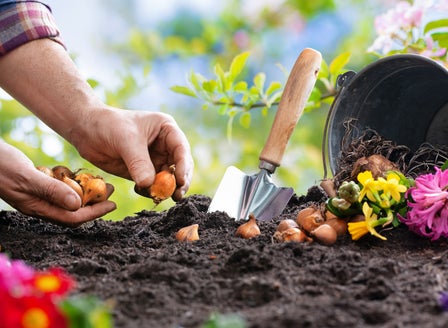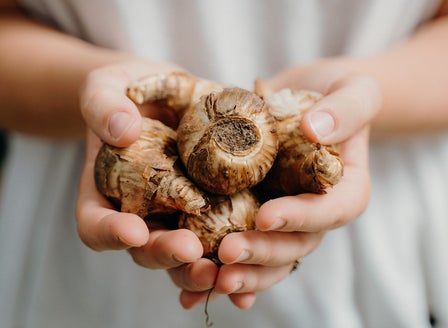Bearded Irises are perennial plants admired for their distinct sword-shaped leaves and striking orchid-like flowers. These blooms come in a wide array of colours, from deep purples and blues to vibrant yellows and whites, making them a popular low -maintenance garden choice. Irises are easy to grow and add charm to your garden year after year.
Planting Calendar
Planting is done in Autumn (late March to mid May) for Spring/Summer flowering
Harvest In
Flower in spring-summer.
Prepare
Discover the sun-loving beauties within the Iris family – the Bearded Irises. Their name arises from the delicate "fuzzy" growth atop the falls, which are the lower three petals of the flower; the upper trio are known as standards. All Bearded Iris blossoms boast these six petals. When the flowers sport a single hue, they're dubbed "Self." For those adorned in multiple colors or bi-tones, they flaunt fanciful names like "Amoena," signifying white standards and colored falls, or "Plicata," denoting petals adorned with dots or lines. Bearded Irises range in size, from the diminutive Miniature Dwarf Bearded to the statuesque Tall Bearded, with an intermediate category referred to as Intermediate and Border Bearded. These irises sprout from rhizomes, which are essentially swollen stems, making them botanically known as rhizomatous. Their name pays homage to the Greek Goddess of the Rainbow. With their appealing grey foliage and magnificent blooms, Bearded Irises stand out as one of the most straightforward and gratifying perennials to cultivate.
Position
Whether planted in the ground or in pots, plant Iris bulbs in full sun with free draining soil for best performance. There more sun the better, a minimum of 6 hours is best. Lack of sun can affect flowering.
Soil
When planted into the ground Iris prefer a free-draining soil that is rich in organic matter. To improve the organic content in your soil, break up the soil and add Kings Compost and Kings Sheep Pellets then mix together well. When growing in containers, plant into Kings Potting mix.
Plant
Bearded Irises don't like to be buried too deep, with no more than 1-2cm of soil. The rhizome likes to bake in the summer sun and feel the cold of winter which encourages flowers. If your garden is super hot and sunny all day, you can give them a bit more soil.
Care
Watering
When it comes to watering Bearded Irises, it's best to follow a simple principle: less is more. Bearded Irises can tolerate dry spells once they are established. In fact, during the summer, you can often leave them to their own devices without much watering. If you absolutely have to, water them every couple of weeks in dry periods. If you're growing Bearded Irises in pots, that's a bit of a different story. Those guys need a bit more attention, especially when it's hot and dry outside. In scorching weather, you might want to water your potted Irises every two to three days to keep them happy. And if you've just planted new Irises, they need more care. Give them a good watering once or twice a week until they've put down some roots and can fend for themselves a bit better.
Feeding
Apply Kings Slow Release Bulb Food in August before flowering and again after flowering.
Protecting
Flowers can get tall too, it is advisable to stake them so they do not blow over in the wind.
Mulching
Never use mulch when growing bearded irises, as this can cause rot.
Spraying
Aphids can feed on the leaves of Iris, spray with Aquaticus Bugtrol as first sign of pests. Rust (a fungal condition) can also be an issue. Spraying for prevention rather than cure is key with rust. Spray with Kiwicare Organic Super Sulphur, avoiding contact with flowers.
Beginner Tip
When using sprays, chemicals or fertilisers always read the label and follow the instructions. Apply sprays in the evening to avoid harming beneficial insects.
Expert Tip
Divide your clumps every 2-5 years. This should be done in summer, after flowering; divisions should be planted in fresh or new soil.
Frequently Asked Questions
What is the best time to plant Bearded Iris?
The best time to plant Bearded Iris is in late summer to early autumn, allowing them to establish roots before winter.
How often should I water Bearded Iris?
When it comes to watering Bearded Irises, it's best to follow a simple principle: less is more. Bearded Irises can tolerate dry spells once they are established. In fact, during the summer, you can often leave them to their own devices without much watering. If you absolutely have to, water them every couple of weeks in dry periods. If you're growing Bearded Irises in pots, that's a bit of a different story. Those guys need a bit more attention, especially when it's hot and dry outside. In scorching weather, you might want to water your potted Irises every two to three days to keep them happy. And if you've just planted new Irises, they need more care. Give them a good watering once or twice a week until they've put down some roots and can fend for themselves a bit better.
How do I prevent pests and diseases in Bearded Iris?
Regularly inspect for pests like iris borers and use organic insecticides if needed. Ensure good air circulation to prevent fungal diseases.
What should I do if my Bearded Iris isn’t blooming?
Ensure your Bearded Iris gets enough sunlight and isn't overcrowded. Check for pests and diseases, and divide if necessary.
How do I care for Bearded Iris after they bloom?
After blooming, remove spent flowers to prevent seed formation. Leave the foliage to die back naturally to nourish the rhizomes for next year.

